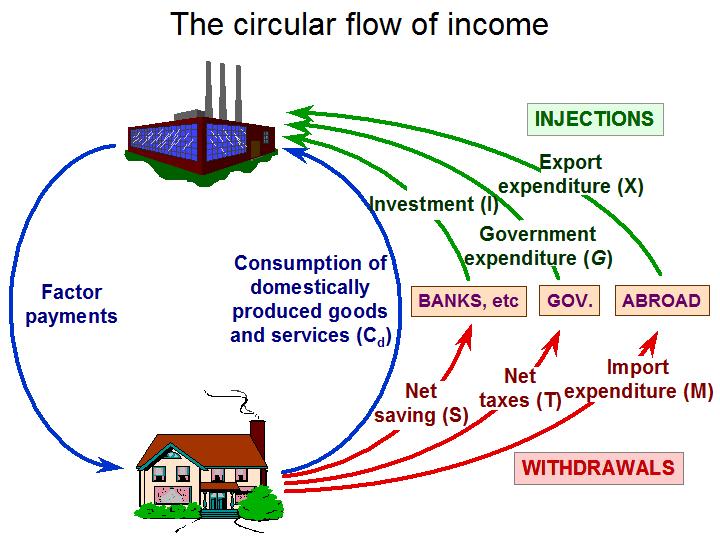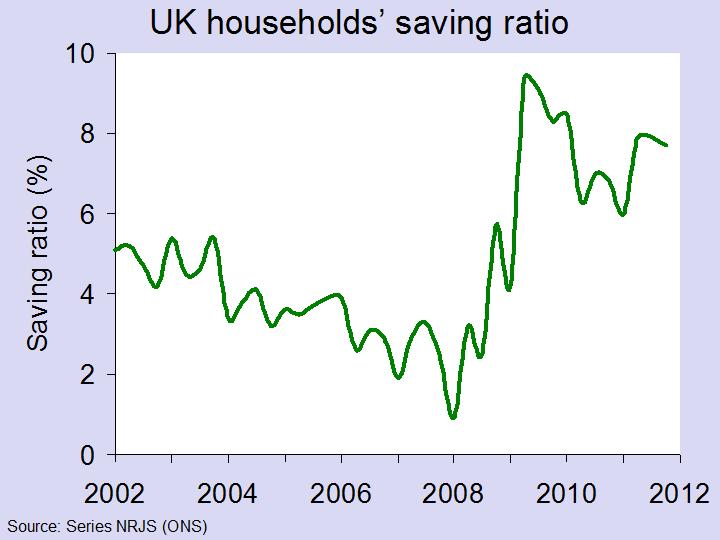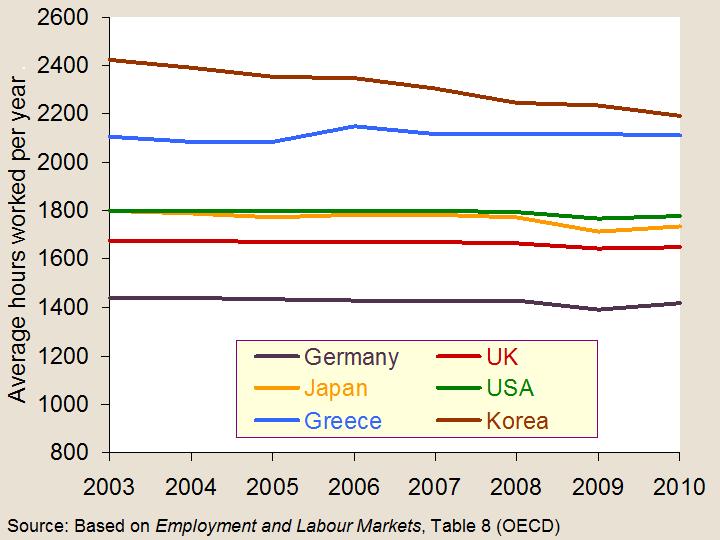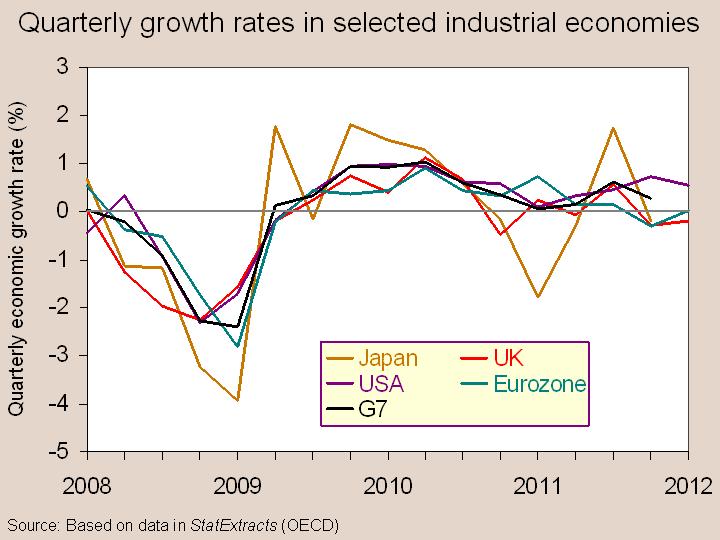 At the Mansion House dinner on 15 June, the Chancellor, George Osborne, and the Governor of the Bank of England, Sir Mervyn King, announced a new monetary policy initiative to increase bank credit. The idea is to stimulate borrowing by both firms and households and thereby boost aggregate demand.
At the Mansion House dinner on 15 June, the Chancellor, George Osborne, and the Governor of the Bank of England, Sir Mervyn King, announced a new monetary policy initiative to increase bank credit. The idea is to stimulate borrowing by both firms and households and thereby boost aggregate demand.
There are two parts to the new measures:
1. Funding for lending. The aim here is to provide banks with cheap loans (i.e. at below market rates) on condition that they are used to fund lending to firms and households. Some £80 billion of loans, with a maturity of 3 to 4 years, could be made available to banks under the scheme. The details are still being worked out, but the scheme could work by the Bank of England supplying Treasury bills to the banks in return for less secure assets. The banks could then borrow against these bills in the market in order to lend to customers.
2. Providing extra liquidity to banks through six-month repos. The Bank of England will begin pumping up to £5bn a month into the banking system to improve their liquidity. This is an activation of the ‘Extended Collateral Term Repo Facility’ (see also), which was created last December, to provide six-month liquidity to banks against a wide range of collateral.
 But whilst it is generally accepted that a lack of borrowing by firms and households is contributing to the slowdown of the UK economy, it is not clear how the new measures will solve the problem.
But whilst it is generally accepted that a lack of borrowing by firms and households is contributing to the slowdown of the UK economy, it is not clear how the new measures will solve the problem.
In terms of the supply of credit, banks have become more cautious about lending because of the increased risks associated with both the slowdown in the UK economy and the euro crisis. They claim that the issue is not one of a shortage of funding for lending, but of current uncertainties. They are thus likely to remain reluctant to lend, despite the prospect of extra loans from the Bank of England.
In terms of the demand for credit, both businesses and consumers remain cautious about borrowing. Even if bank loans are available, firms may not want to invest given the current uncertainties about the UK, eurozone and world economies. Consumers too may be reluctant to borrow more when people’s jobs may be at stake or at least when there is little prospect of increased wages. Even if banks were willing to lend more, you cannot force people to borrow.
Britain fights euro zone threat with credit boost Reuters, Matt Falloon and Sven Egenter (14/6/12)
Debt crisis: emergency action revealed to tackle ‘worst crisis since second world war’ Guardian, Larry Elliott, Jill Treanor and Ian Traynor (14/6/12)
Q&A: Funding for lending scheme Financial Times, Norma Cohen (15/6/12)
Bank lending plan: How will it work? BBC News (15/6/12)
Bank of England’s loans to high street banks start next week Guardian, Phillip Inman (15/6/12)
 Mervyn King: Bank of England and Treasury to work together The Telegraph (15/6/12)
Mervyn King: Bank of England and Treasury to work together The Telegraph (15/6/12)
 Bank of England offers £80bn loans Channel 4 News, Sarah Smith (15/6/12)
Bank of England offers £80bn loans Channel 4 News, Sarah Smith (15/6/12)
Bank funding scheme plans unveiled Independent, Holly Williams (15/6/12)
Banking: King hits panic button Independent, Ben Chu (15/6/12)
Bankers raise doubts on credit scheme Financial Times, Patrick Jenkins and Sharlene Goff (15/6/12)
We should not pin our hopes on Britain’s plan A-plus Financial Times, Martin Wolf (15/6/12)
Throwing money at banks won’t solve economic crisis, Ed Balls says Guardian, Patrick Wintour (15/6/12)
UK lending plan faces risk of low take-up BloombergBusinessweek, Robert Barr (15/6/12)
Will Bank of England’s new lending schemes work? BBC News, Robert Peston (15/6/12)
Bank and Treasury’s plan A-plus for UK BBC News, Stephanie Flanders (15/6/12)
Questions
- How would the schemes incentivise banks to lend more?
- Explain what is meant by the Extended Collateral Term Repo Facility. How similar is it to the long-term repo operations of the ECB (see the news item More bank debt to ease bank debt)?
- What factors are likely to determine the take-up of loans from banks?
- Will the new arrangements have any implications for taxpayers? Explain.
- To what extent are fiscal and monetary policy currently complementary?
- What is the significance of calling the new measures ‘Plan A-plus’? What would ‘Plan B’ be?
 If one person saves more, then it will increase that person’s consumption possibilities in the future. If, however, everyone saves more, and hence spends less, then businesses will earn less and are likely to respond by producing less if the decline in aggregate demand continues. Hence if a country saves more, people could be worse off. That’s the paradox of thrift.
If one person saves more, then it will increase that person’s consumption possibilities in the future. If, however, everyone saves more, and hence spends less, then businesses will earn less and are likely to respond by producing less if the decline in aggregate demand continues. Hence if a country saves more, people could be worse off. That’s the paradox of thrift.
There is considerable debate around the world at the moment about the desirability of austerity policies. The debate has become more intense with the worsening economic outlook in many European countries and with the election in France of François Hollande who rejects many of the austerity measures of his predecessor, Nicolas Sarkozy.
 But can further stimulus be given to aggregate demand without causing a further worsening of countries’ public-sector debt positions and causing a fall in confidence in financial markets? And how would that impact on investment?
But can further stimulus be given to aggregate demand without causing a further worsening of countries’ public-sector debt positions and causing a fall in confidence in financial markets? And how would that impact on investment?
And in the meantime, as the economic outlook darkens, people are trying to save more, despite low interest rates. The paradox of thrift seems to be getting more acute. (Click here for a PowerPoint of the chart.)
Articles
How National Belt-Tightening Goes Awry New York Times, Robert J. Shiller (19/5/12)
Japan disease is spreading: High risk and low returns Firstpost (India), Vivek Kaul (17/5/12)
The Solution can not be More Debt Huffington Post, Jill Shaw Ruddock (29/5/12)
Crediting debt Breaking Views, Edward Hadas (30/5/12)
Green investments can overcome the paradox of thrift New Statesman, Dimitri Zenghelis (7/6/12)
Austerity has never worked Guardian, Ha-Joon Chang (4/6/12)
The False Choice Between Austerity And Growth Forbes (24/5/12)
It’s not a case of austerity v stimulus for Europe Guardian, Paul Haydon (1/6/12)
Data
UK households’ saving ratio: series NRJS ONS
Household saving rates for OECD countries StatExtracts: OECD
Questions
- Why may we be experiencing a paradox of thrift at the current time?
- What are the arguments for the use of fiscal and monetary policies to expand aggregate demand at the current time?
- What are the arguments against the use of fiscal and monetary policies to expand aggregate demand at the current time?
- Can economic growth be stimulated by a redistribution of aggregate demand and, if so, in what way?
- Can green investment overcome the paradox of thrift?
- To what extent are demand-side and supply-side policies (a) complementary; (b) contradictory? Or, to put the question another way, to what extent may policies to encourage growth in the long term damage growth in the short term and vice versa?
 Countries differ considerably in terms of the number of hours people work.
Countries differ considerably in terms of the number of hours people work.
Despite the criticisms levelled at Greece, with some claiming that Greek workers are ‘lazy’, according to 2010 figures, the average worker in Greece worked 2109 hours per year – more than in any other European country. The average German worker worked 1419 hours and the average Dutch worker only 1377.
Internationally, amongst developed countries, Korea has the highest number of working hours per worker at 2193 per year. In the USA, the figure is 1778 hours and in the UK it’s 1647. (Click on chart below for a larger version.)
 But working long hours does not mean working more productively. Generally the countries in which people work longer hours have lower output per hour.
But working long hours does not mean working more productively. Generally the countries in which people work longer hours have lower output per hour.
The following podcast and articles look at the relationship between hours worked and productivity and consider which way the causality lies. They also look at related issues such as the proportion of part-time working and the length of annual paid holidays.
Podcast
 Hardest Working Nations (also at) More or Less: BBC Radio 4, Tim Harford talks to Jon Messenger from the ILO (18/5/12)
Hardest Working Nations (also at) More or Less: BBC Radio 4, Tim Harford talks to Jon Messenger from the ILO (18/5/12)
Articles
Who works the longest hours? BBC News Magazine, Wesley Stephenson (23/5/12)
Are Greeks the hardest workers in Europe? BBC News Magazine, Charlotte McDonald (26/2/12)
Book
Working Time around the World ILO, Sangheon Lee, Deirdre McCann and Jon C. Messenger (Routledge, 2007)
Data
International Comparisons of Productivity – 2010 – Final Estimates: Statistical Bulletin ONS (6/3/12)
International Comparisons of Productivity – 2010 – Final Estimates: Data ONS (6/3/12)
Productivity Statistics OECD
Table 8: Average annual working time: Hours per worker Employment and Labour Markets, OECD
Questions
- Which countries tend to work the longest hours?
- Would cutting working hours, either through legislation or by agreement with companies, allow more people to be employed? Explain why it might be more complicated than this.
- What is the relationship between labour productivity per hour and the average number of hours worked per worker? Do people work longer hours because they are less productive or are they less productive because they work longer hours?
- Why factors determine labour productivity?
- Why may average hours worked be deceptive in terms of assessing how hard people are working?
- Why do US workers work more hours per year on average than UK workers?
 In the models of perfect and monopolistic competition, the long-run equilibrium involves firms making zero supernormal profit. The key assumption driving this outcome is that supernormal profits in the short run attract new entrants to the market.
In the models of perfect and monopolistic competition, the long-run equilibrium involves firms making zero supernormal profit. The key assumption driving this outcome is that supernormal profits in the short run attract new entrants to the market.
Increased competition then results in lower prices for consumers and firms’ profits fall. Therefore, an important question is how long does it take for this process to take place?
In a recent post on the Freakonomics blog, Daniel Hamermesh describes a situation in which he was actually able to observe this adjustment process taking place amongst buskers in the centre of Madrid.
This interesting example illustrates that, at least in some cases, this process can start even before entry occurs. This is because incumbents are able to make adjustments to their existing strategies, in the case of the buskers by changing their location. Consequently, profitable opportunities start to be eroded away very quickly.
Perfect competition Chillin’Competition blog, (24/10/11)
Questions
- What are the assumptions of the model of monopolistic competition?
- What is the difference between monopolistic and perfect competition?
- Does the market for buskers fit well with the assumptions of monopolistic competition?
- In this market what might be the benefits for consumers of increased competition?
- What are the key strategies incumbents might use in this market?
- How long do you think entry might take in this market?
 In the third and final part of this blog, we look at the G8 summit at Camp David on 18 and 19 May 2012. Ways of averting the deepening global economic crisis were top of the agenda.
In the third and final part of this blog, we look at the G8 summit at Camp David on 18 and 19 May 2012. Ways of averting the deepening global economic crisis were top of the agenda.
In terms of the global economy, the leaders agreed on three main things. The first was that they supported Greece remaining in the euro. According to the communiqué:
We agree on the importance of a strong and cohesive eurozone for global stability and recovery, and we affirm our interest in Greece remaining in the eurozone while respecting its commitments. We all have an interest in the success of specific measures to strengthen the resilience of the eurozone and growth in Europe
The second was a commitment to ‘fiscal responsibility’ and the clawing down of public-sector deficits.
We commit to fiscal responsibility and, in this context, we support sound and sustainable fiscal consolidation policies that take into account countries’ evolving economic conditions and underpin confidence and economic recovery.
 The third was commitment to boosting economic growth. (Click on chart for a larger image.) On the supply side this would be through measures to stimulate productivity. On the demand side this would be through policies to stimulate investment.
The third was commitment to boosting economic growth. (Click on chart for a larger image.) On the supply side this would be through measures to stimulate productivity. On the demand side this would be through policies to stimulate investment.
(For a PowerPoint of the chart, click on the following link: Quarterly Growth.)
To raise productivity and growth potential in our economies, we support structural reforms, and investments in education and in modern infrastructure, as appropriate. Investment initiatives can be financed using a range of mechanisms, including leveraging the private sector. Sound financial measures, to which we are committed, should build stronger systems over time while not choking off near-term credit growth. We commit to promote investment to underpin demand, including support for small businesses and public-private partnerships.
But the communiqué was short on details. How will fiscal consolidation be achieved? Does this mean a continuation of austerity measures? And if so, what will be the impact on aggregate demand? Or if fiscal consolidation is slowed down, what will be the impact on financial markets?
If a growth in investment is central to the policy, what will be the precise mechanisms to encourage it? Will they be enough to combat the deflationary effect on demand of the fiscal measures?
And how will productivity increases be achieved? What supply-side measures will be introduced? And will productivity increases be encouraged or discouraged by continuing austerity measures?
Lots of questions – questions raised by the articles below.
Articles
Capitalism at a crossroads Independent (19/5/12)
 Barack Obama warns eurozone to focus on jobs and growth The Telegraph (20/5/12)
Barack Obama warns eurozone to focus on jobs and growth The Telegraph (20/5/12)
G8 Summit: World leaders push for Greece to stay in the eurozone The Telegraph, Angela Monaghan (19/5/12)
Obama sees ’emerging consensus’ on crisis Sydney Morning Herald, Ben Feller and Jim Kuhnhenn (20/5/12)
G8 leaders tout economic growth, fiscal responsibility CNN (20/5/12)
G8 focuses on Eurozone Gulf News (20/5/12)
G8 leaders back Greece amid tensions France 24 (20/5/12)
G8 splits over stimulus versus austerity Financial TimesRichard McGregor and Kiran Stacey (19/5/12)
Cameron is consigning the UK to stagnation Financial Times, Martin Wolf (17/5/12)
Time to end ‘Camerkozy’ economics Financial Times, Ed Miliband (18/5/12)
Obama: Eurozone ‘must focus on jobs and growth’ BBC News (20/5/12)
World leaders back Greece, vow to combat financial turmoil Reuters, Jeff Mason and Laura MacInnis (19/5/12)
Germany isolated over euro crisis plan at G8 meeting in Camp David Guardian, Patrick Wintour (19/5/12)
G8 leaders end summit with pledge to keep Greece in eurozone Guardian, Ewen MacAskill (19/5/12)
G8 summit ends with few tangible results Xinhua, Sun Hao (20/5/12)
Final communiqué
Camp David DeclarationG8 (19/5/12)
Questions
- To what extent are economic growth and fiscal consolidation (a) compatible; (b) incompatible objectives? How might a Keynesian and a new classical economist respond to these questions?
- What supply-side measures could be introduced by the EU?
- Why might dangers of protectionism increase in the coming months?
- What would be the impact of a Greek default and exit from the eurozone on other eurozone economies?
- What monetary policy changes could be introduced by the eurozone governments and the ECB in order to ease the sovereign debt crisis of countries such as Grecce, Spain, Portugal, Italy and Ireland?
 At the Mansion House dinner on 15 June, the Chancellor, George Osborne, and the Governor of the Bank of England, Sir Mervyn King, announced a new monetary policy initiative to increase bank credit. The idea is to stimulate borrowing by both firms and households and thereby boost aggregate demand.
At the Mansion House dinner on 15 June, the Chancellor, George Osborne, and the Governor of the Bank of England, Sir Mervyn King, announced a new monetary policy initiative to increase bank credit. The idea is to stimulate borrowing by both firms and households and thereby boost aggregate demand. But whilst it is generally accepted that a lack of borrowing by firms and households is contributing to the slowdown of the UK economy, it is not clear how the new measures will solve the problem.
But whilst it is generally accepted that a lack of borrowing by firms and households is contributing to the slowdown of the UK economy, it is not clear how the new measures will solve the problem. Mervyn King: Bank of England and Treasury to work together The Telegraph (15/6/12)
Mervyn King: Bank of England and Treasury to work together The Telegraph (15/6/12) Bank of England offers £80bn loans Channel 4 News, Sarah Smith (15/6/12)
Bank of England offers £80bn loans Channel 4 News, Sarah Smith (15/6/12)





